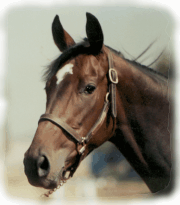|

|
A
Horse of Course
by Don Blazer |
What is isn't necessarily what was. And what was could still be
what is, only with a different name.
I said the Lone Ranger, Napoleon, El Cid and Gen. Zachary Taylor
all rode albinos. They, of course, did not. And I said albinos
are not weak, do not die young and do not have poor eyesight.
They, of course, don't because they are not. Albinos are not any
of those things because they are not-albinos, that is.
Wendy Bockman took exception to most of what I said, and rightly
so. Wendy is the co-founder of the Cremello & Perlino Education
Association (CPEA). She set me straight, explaining that albinos
have never been documented to exist in the equine species, and
that what we once called albinos were actually Cremellos and Perlinos,
also known as Double Dilutes. Wendy explains that Double Dilutes
have coat colors ranging from pale ivory to light gold, have pumpkin/salmon
colored skin and blue eyes. Any white markings will have pink
skin just like any other horse, she said. Cremellos have white
manes and tails, and Perlinos have golden-hued mane,
tail and points. Both can have white markings, dappling and shadowing.
According to Wendy, Cremellos and Perlinos appear in every breed
of horse in which single dilute colors, such as buckskins, palominos
and smoky blacks occur naturally. When you breed single dilute
horses together, you have a 25 per cent chance of getting a double
dilute foal.
"Many breed registries consider the double-dilute genes a
gold mine because they are homozygous for the dilution gene and
will only produce single dilute colors (buckskin, palomino and
smoky black) when bred to non-dilute colors," she said.
I have to say at this point, in my defense, that I did say what
was called an albino was actually just a white horse. Back when
what isn't was, there was actually an active American Albino Association
which registered white horses as a color type rather than a no-color
breed. The association no longer exists.
The American Quarter Horse Association (AQHA) eliminated the word
"albino" in their registry rule 227i, which states "no
horse is eligible for registration which possesses all three characteristics:
light (or pink) skin over the body; white or cream colored hair
over the body; and eyes of a bluish cast." The rule once
contained the phrase, "commonly known as albino."
The AQHA still excludes double dilutes from registry. Gary Griffith
of the registration department explained there is still the feeling
among some committee members that Cremellos and Perlinos have
health and vision problems.
Asked if AQHA had documentation backing that opinion, Griffith
said, "No, and that is why the committee is very serious
about addressing this question." According to Griffith there
is a growing movement to change the color rule.
So
now there are no albinos, but when there were, they were really
just what they are-Cremellos and Perlinos. And there is no scientific
evidence indicating Cremellos and Perlinos have health or vision
issues, according to Wendy.
I'm no expert on coat color genetics. Dr. Jim McCall is an expert.
And if you want to possess a little more expertise on the matter
you can enroll in his online course, Coat Color Genetics, which
earns you a college certificate of recognition upon completion.
You can see a sample of one of the lessons and some quiz questions
on my web site: www.donblazer.com.
If you want a little more information on Cremellos and Perlinos,
then log on to the CPEA web site: www.doubledilute.com.
I
don't want to end this matter in a state of confusion as to what
is and what isn't. So keep this in mind: Piebald describes any
black and white colored horse. Skewbald describes white spotting
on a horse of any color other than black. How's that for clarification?
Visit A Horse, Of Course online at www.donblazer.com
.







